Astrolux MF01 review

Astrolux MF01 Mini Specifications
| Brand / Model | Astrolux MF01 Mini |
|---|---|
| Category | EDC flashlights |
| LED | Luminus SST-20 |
| Lumens | 6,300 Lm |
| Beam intensity | 43000 cd |
| Battery config. | 1*26650 |
| Material | Aluminium w/ Stainless bezel |
| Modes | Lots! The MF01 Mini runs Andúril. |
| Blinkies | Candle, Lightning, Bike Strobe, Party Strobe, Tactical Strobe |
| Reflector | TIR |
| Waterproof | **IPX7 (1m underwater). |
| Review date | November 2019 |
**That said, Astrolux recommend not immersing it.
Introduction:
The Astrolux MF01 Mini. The little brother of the MF01S, itself the newer and improved upgrade of the MF01. Seven SST-20 emitters under a TIR frame, 26650 (or 21700, or 18650), Aux LEDs, Andúril.
I’ve been looking forward to this light since it was announced on BudgetLightForum in March 2019 – I have an MF01 that I’ve modified, and this would compliment it nicely. As time passed, my interest waned with other lights coming out and things taking longer than expected, and then as more information came out, my ears started twitching again. It’s finally here, so it’s time to review it!
I’ve opted to do all measurements and testing both with the Samsung 40T 21700 and the Keeppower “Black” 26650 5200mAh to give a good representation of cells people may use in the light.
What you’ll get:
The MF01 Mini was packaged in the traditional Astrolux box – a white box with an outline image of the light, along with labelling on the side to indicate the colour and emitter. I quite like the Astrolux boxes, as they’re sturdy, and the amount of foam inside provides good protection for shipping.
Inside the box, we find:
- The MF01 Mini itself, nestled in said foam
- User manual
- Spacers to fit a 21700 or an 18650
- A lanyard
- Spare O-rings
Sadly, this doesn’t include a USB-A to USB-C cable – this is needed for onboard charging, as the battery inside will not charge if using USB-C only. I believe it has to do with extra circuitry required for step-down, and there are only a very small number of lights on the market that can do this out of the box. Don’t forget to check out the list with the best rechargeable flashlights!
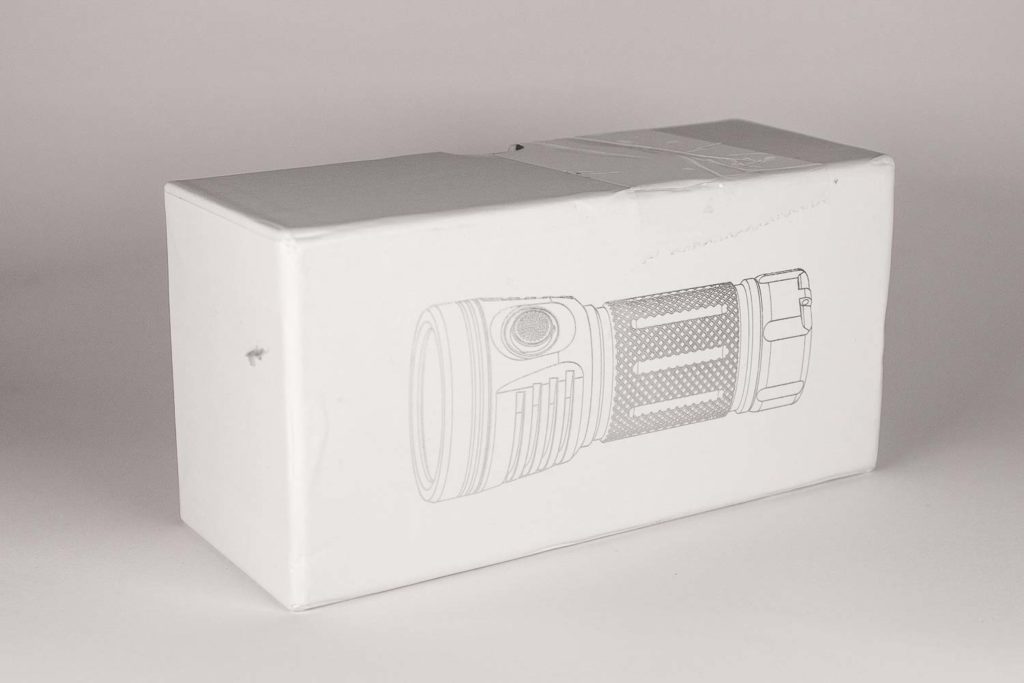
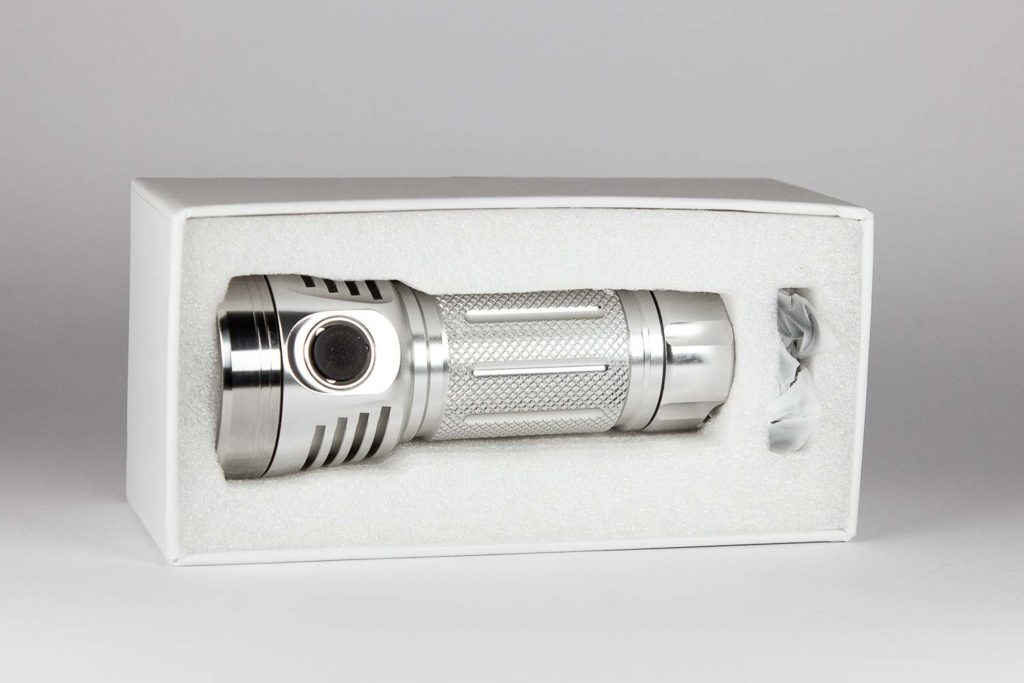
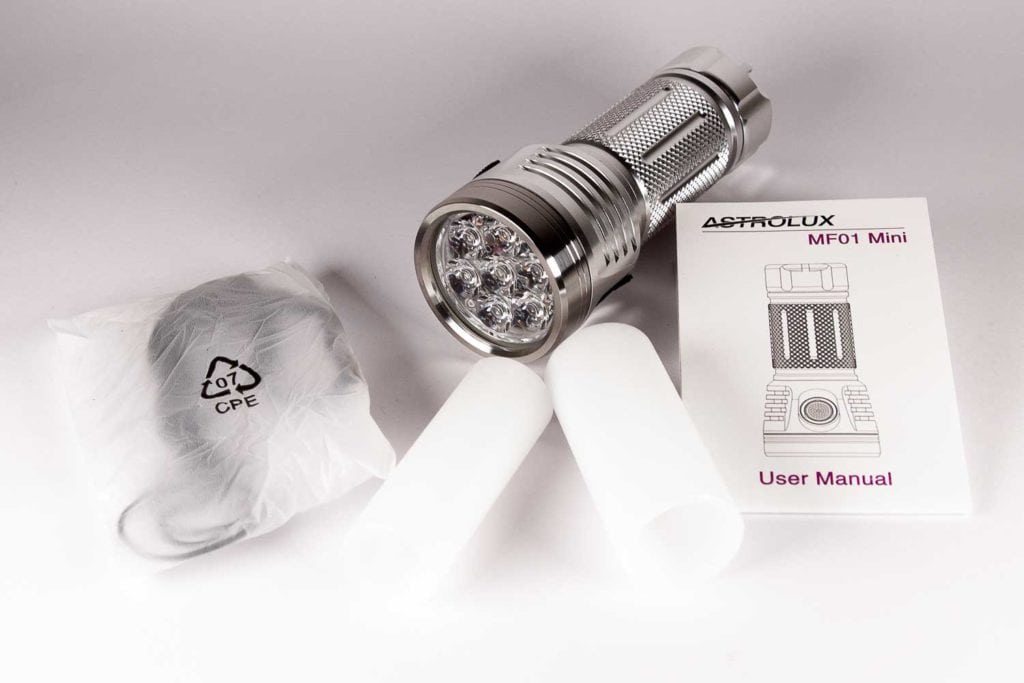
Handling of the light
The light fits very neatly inside my hand, and has a good heft to it. The button is slightly proud, which lets your thumb rest on it neatly without having to search for it. It’s a little top-heavy, as would be expected from the style of light, but in practice I found it works quite well – while walking at night with it, it tended to make my hand drift downwards, which gave me more of an indication on the ground stretching out in front of me – very welcome when on uneven ground.
The lanyard included is… well, I’ve made mention in the past of Convoy S12’s lanyards being rather small, and perhaps not compatible with larger hands, and this light is no exception. I can just fit it over my hand, but with quite a bit of effort.
That said, once it’s on, it’s solid.
Tail standing:
- Not a problem at all. The tail is quite large and flat, which is brilliant for utilizing Candle and Lightning mode. The lanyard loop is off to the side, so this doesn’t interfere.
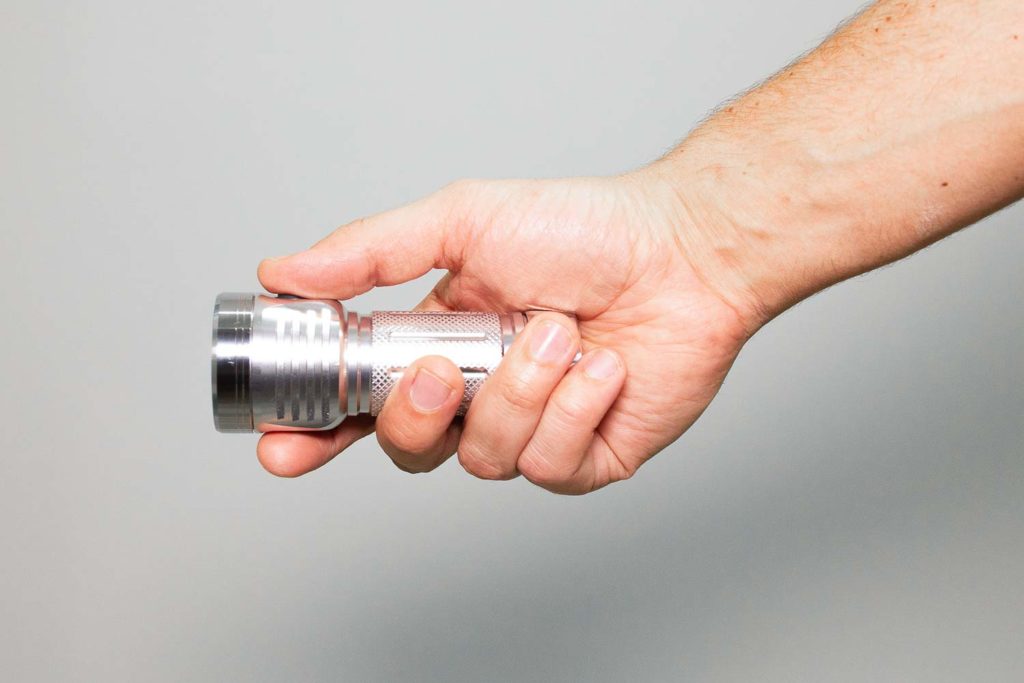
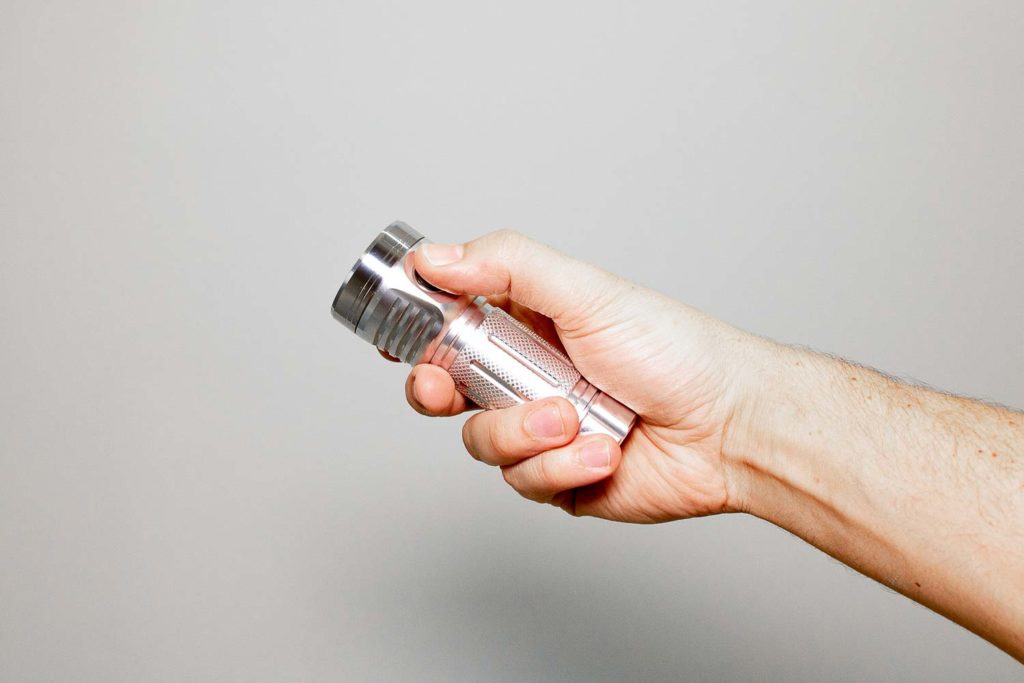
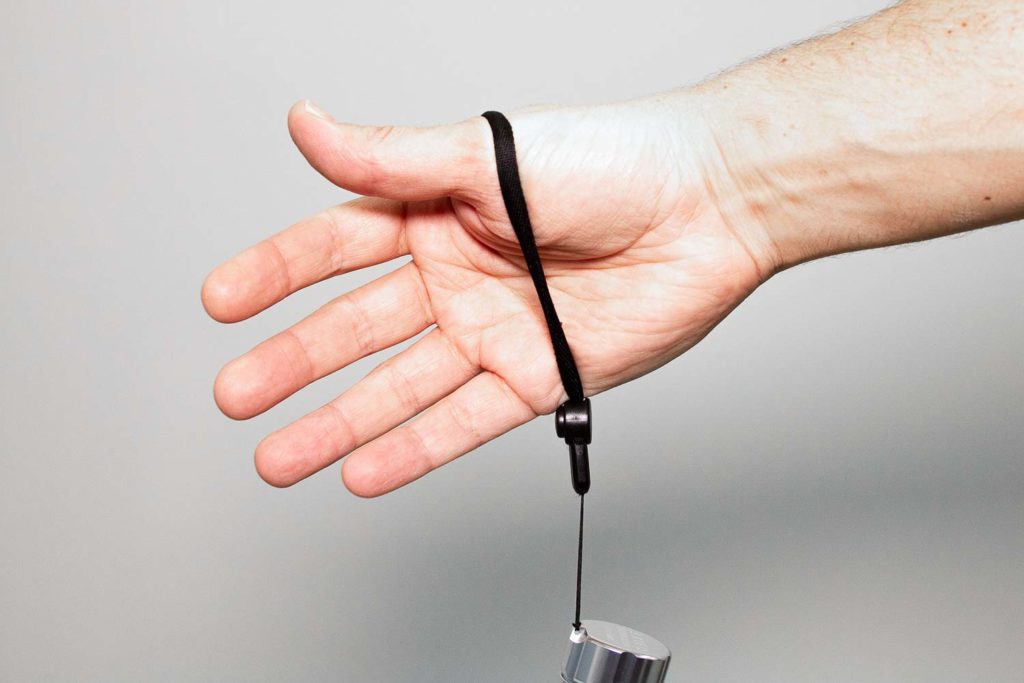
Build Quality, knurling, threads, and anodization
Build quality is as expected from Astrolux – everything is fine. While perhaps not having the precise machining of higher-end brands, there’s no particular issue I can see anywhere – all threads move smoothly, all o-rings are seated well, threads are well lubricated, the rubber cap over the charge port is solid, the knurling is grippy without being rough – the list goes on.
The light I have is in clear anodization, so I can’t immediately see if there are any particular issues with thickness or marks, but I can’t feel any particular issues with it after running my hands over it. There were some slight markings on the tailcap, but these are more likely machining marks than anything else.
As mentioned above, the lubrication on the threads is good, and this carries over to the o-rings. The light is rated at IPX7, which indicates it can be submerged in 1m of water.
Knurling is a cross-hatch effect, and provides a good grip, ensuring that it stays where you put it in your hand – the tailcap has larger notches to provide great grip when opening and closing it.
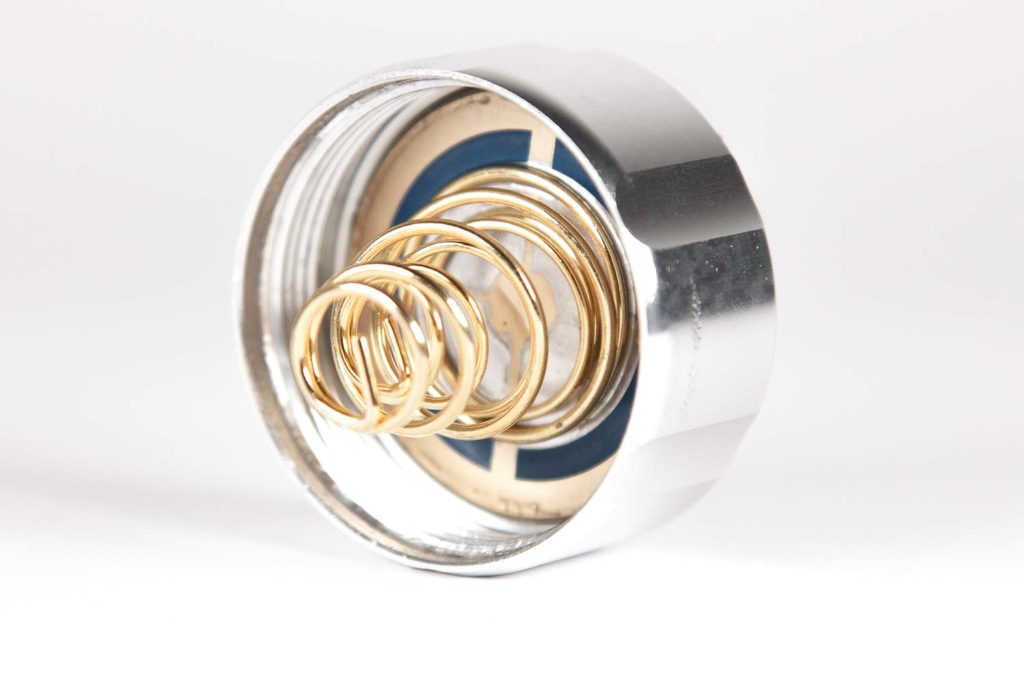
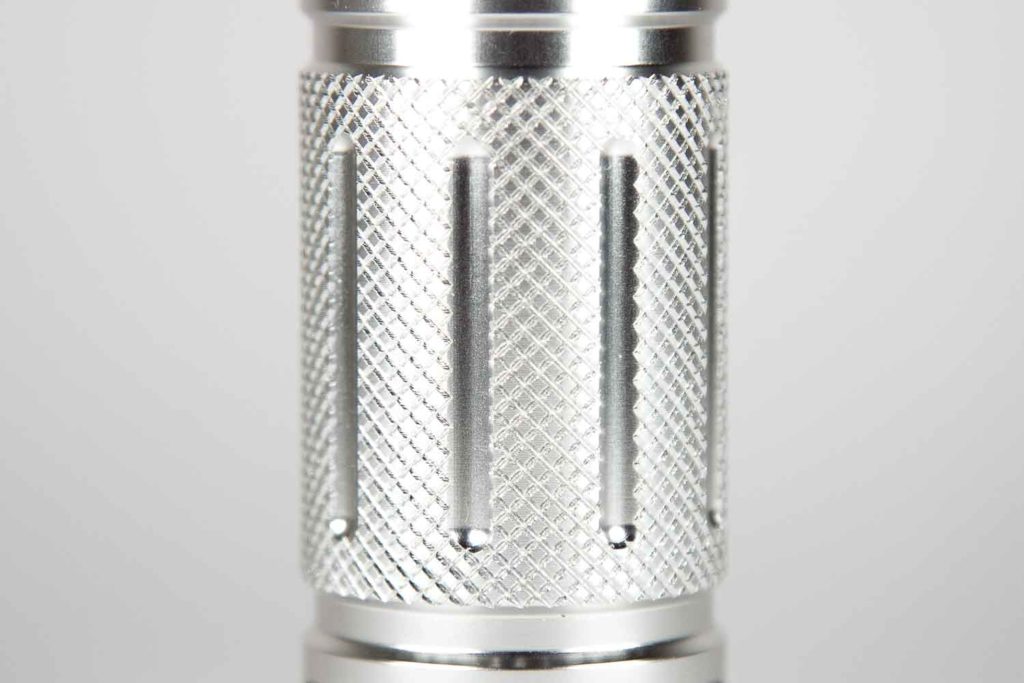
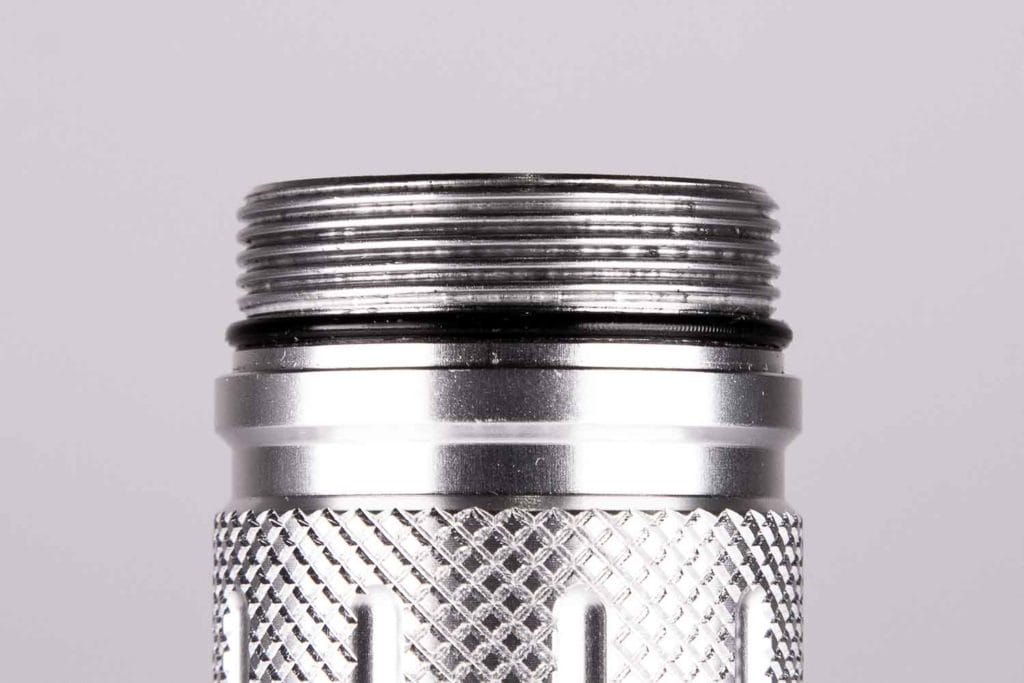
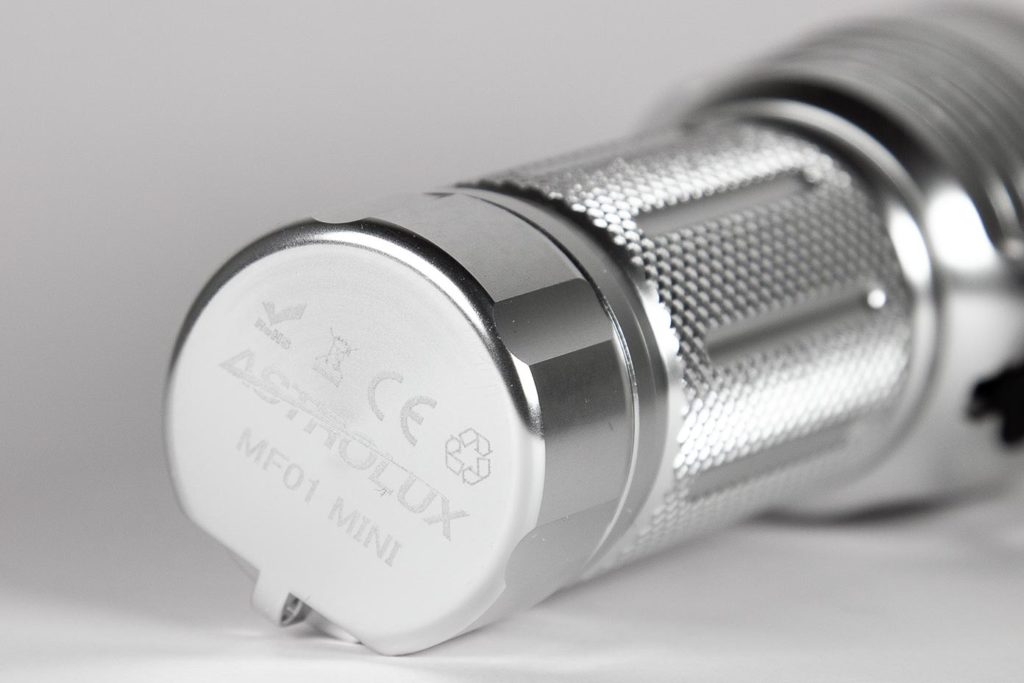
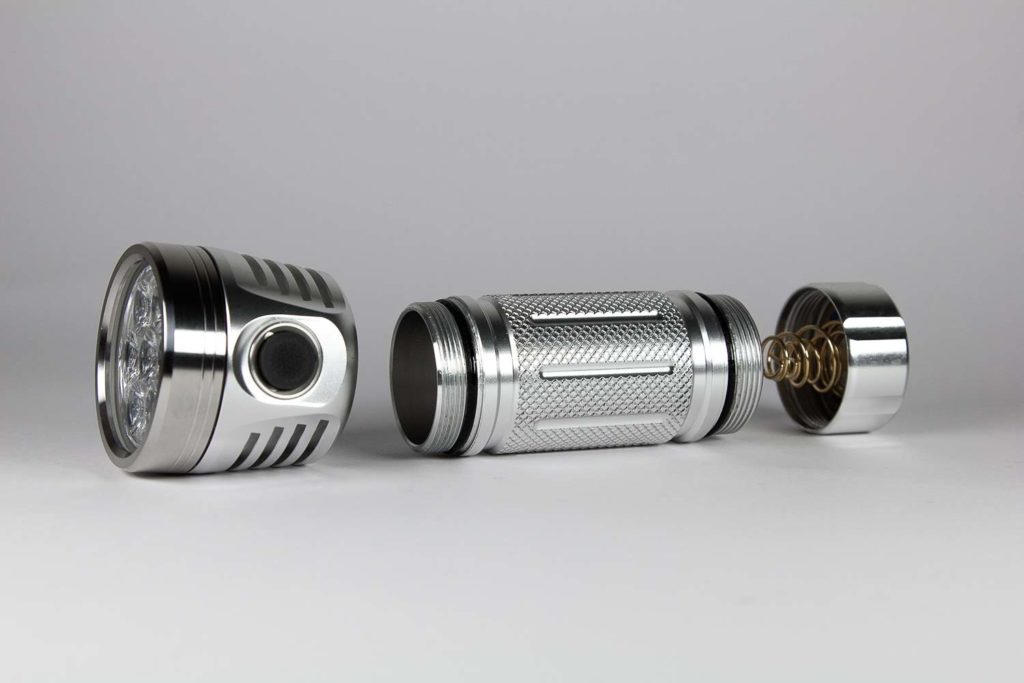
LEDs, Lens, Bezel and Reflector
The emitter on the light I received is the Luminus SST-20 5000K – I’ve got mixed feelings about this one. The SST-20 is known for having great high-CRI emitters in the 4000K and lower range, but are only 70CRI above that – this, however, is the second consideration after the fact that the 5000K (and most other emitters in the SST-20 range) is greeeeeen at low modes. As in, incredibly so, if you’re a tint snob such as myself.
A beamshot comparison below is an FW3A with the rosy sw45k, the MF01 Mini SST-20 5000K, and then a Convoy S12 Nichia 219C 4000K. (The picture gives you an idea, but will not be the same as you’ll see in person)
That said – once you turn up the power, and I’d say most people who are getting a 7-emitter light would be, the green mostly disappears. For most people, I don’t think this would be a particularly big issue, but I’ve mentioned it as I have seen several threads in the last few weeks regarding these emitters, and it would be remiss of me to omit it.
The lens of the light is a 7x TIR under some AR glass, reminiscent of a more-emitters version of a Carclo 10507 (in that it’s a clear TIR).
On top of all that is a lovely stainless steel bezel with accents. I’m very happy about the recent explosion of stainless bezels!
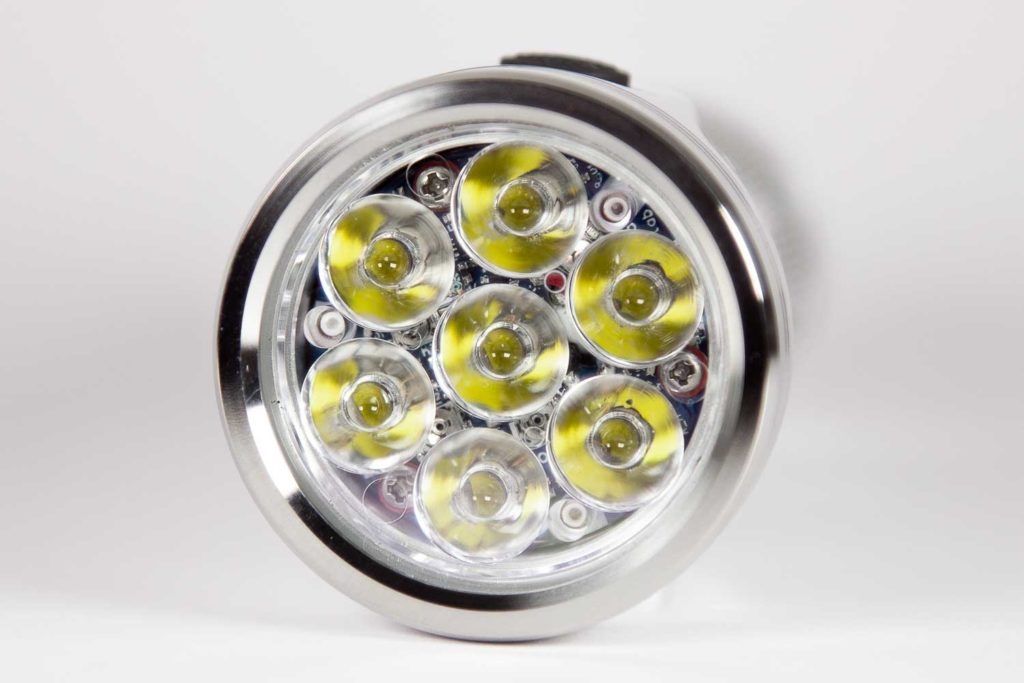
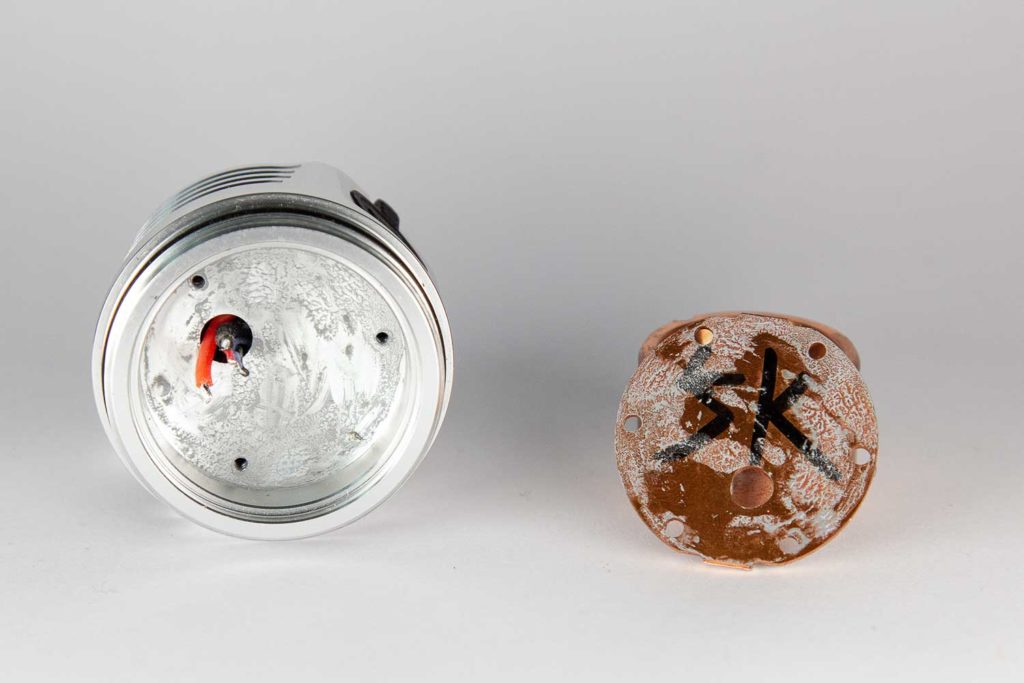

Dimensions:
Length:
- Length: 111mm (4.37“)
- Head diameter: 44mm (1.73”)
- Body diameter: 33mm on knurling (1.3”)
- Tail diameter: 34mm (1.34“)
Weight:
- Empty: 173g (6.1oz)
- With Keeppower 15A 26650: 267g (9.42oz)
- With Samsung 40T and sleeve: 255g (8.99oz) – The 21700 sleeve is 15g (0.53oz).
Popular Flashlights comparison
Image 1 and 2: Astrolux MF01 Mini vs Astrolux MF01
Image 3 compared to the Lumintop FW3A and Convoy S2+
Image 4: compared to the Convoy S12
Image 5: compared to the Sofirn BLF SP36, Imalent MS06.
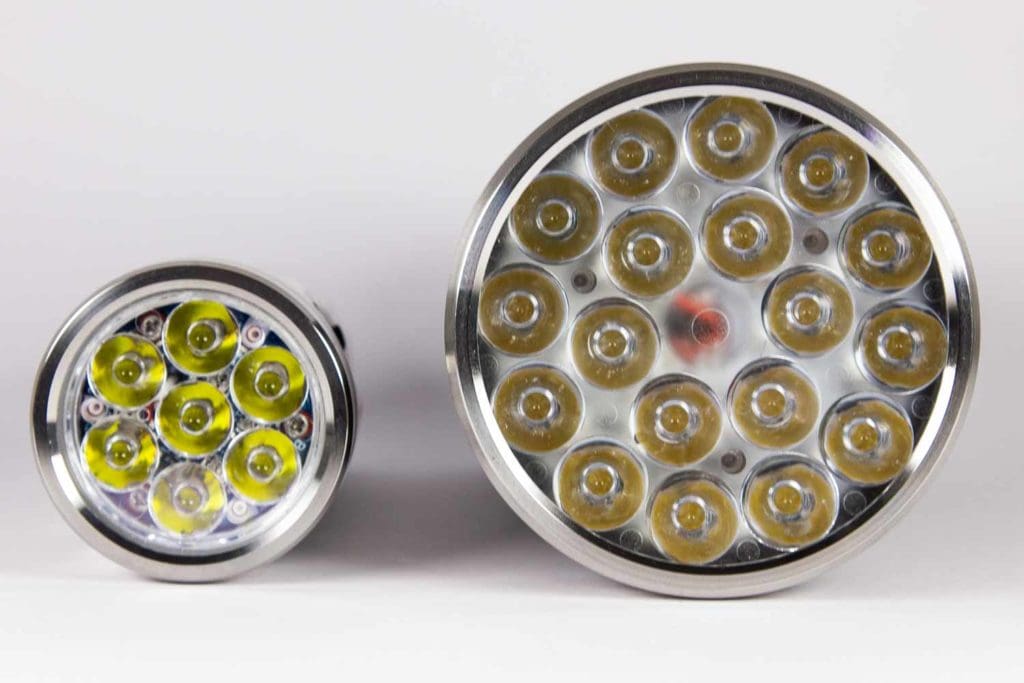
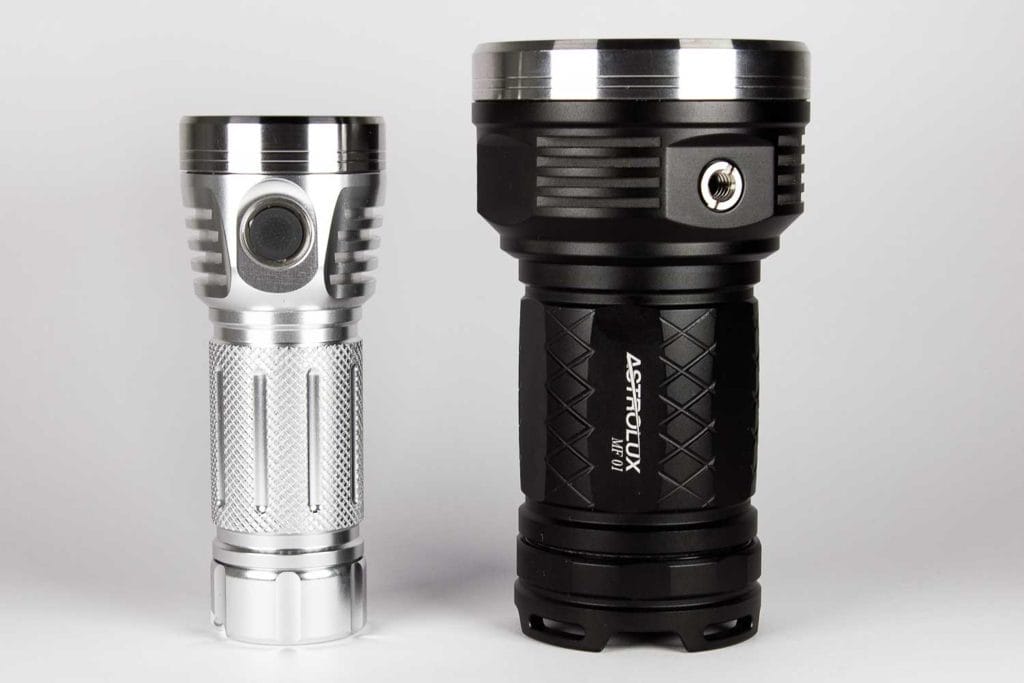
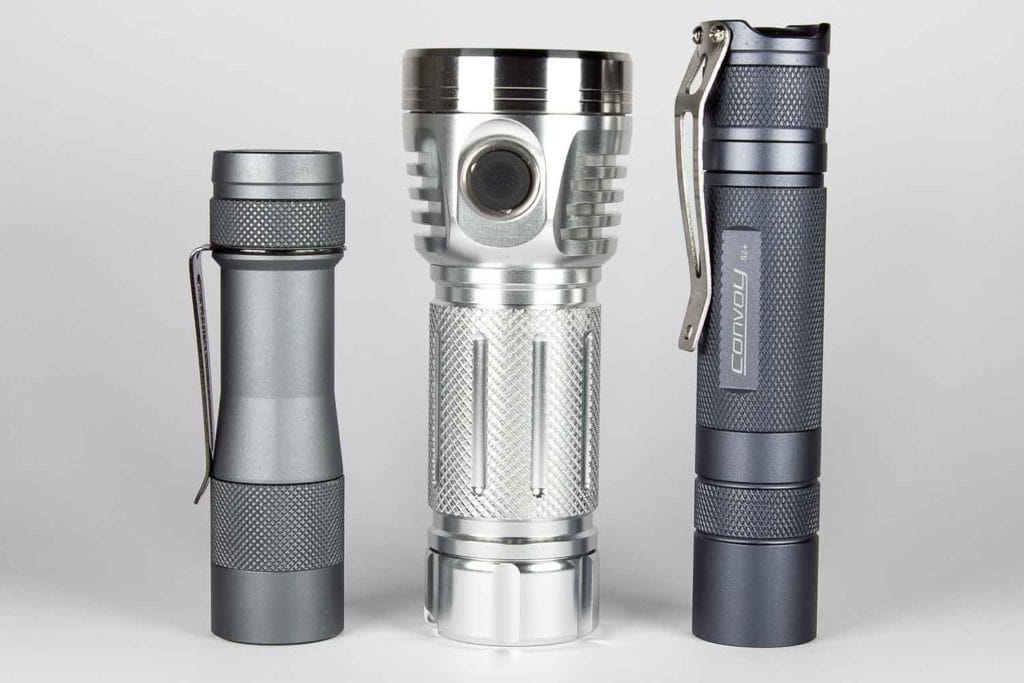
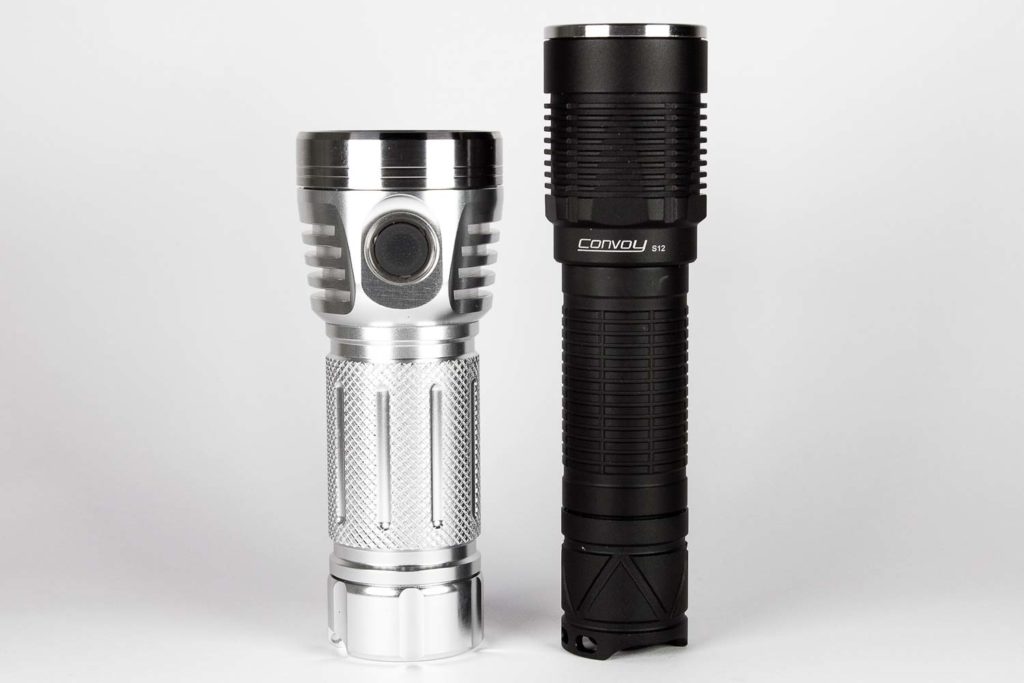
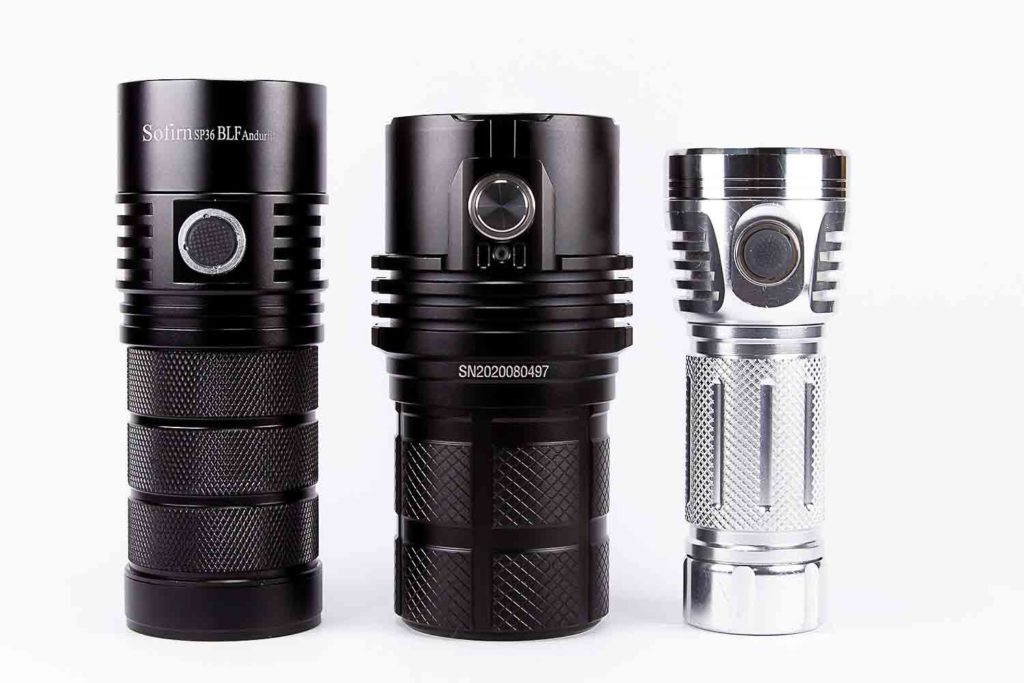
Driver & User Interface:
The MF01 Mini uses a custom FET+6+1 driver running Anduril, which is hands-down my favourite UI. It has a button instead of a spring, which I found somewhat interesting.
Modes:
An awful lot! Anduril is one of the more intuitive UIs I’ve used, while also being extremely customisable. The general gist of it is:
From OFF:
- Click – On (to mode memory).
- Hold click: On to bottom of ramp
- Double Click: On to top of ramp
From ON:
- Click – Off.
- Hold click: ramp (or step) upwards, quickly release and hold again to ramp (or step) downwards
- Double Click: Turbo
From there, it can get ridiculously complicated – a UI diagram is here, and the text-based manual is here. Note that not all of the options in the UI diagram are available; the AUX emitters are fixed colours, and not customisable by software.
The driver board is an FET+6+1, which uses regulated modes below 2.45A. This helps keep output steady, but has a hard limit on brightness – going above that lets the FET take over and pull as much as it can out of the battery. There’s also a USB-C port for charging, but this only works via a USB-C to USB-A cable (sadly, as previously mentioned, not included).
The light has low voltage protection, and lockout is done by either untwisting the tailcap ¼ turn for a mechanical lockout or clicking four times for software lockout. While software locked, holding the button will do the bottom of the ramp, and clicking twice and holding the second will do the bottom of the stepped mode, which by default is slightly brighter.
From what I can see, there’s PWM in all modes (with a note about turbo), but I could only detect this with my camera, and not my eye. In turbo, my camera can’t deal with the exposure to focus enough to be able to determine if it does or not.
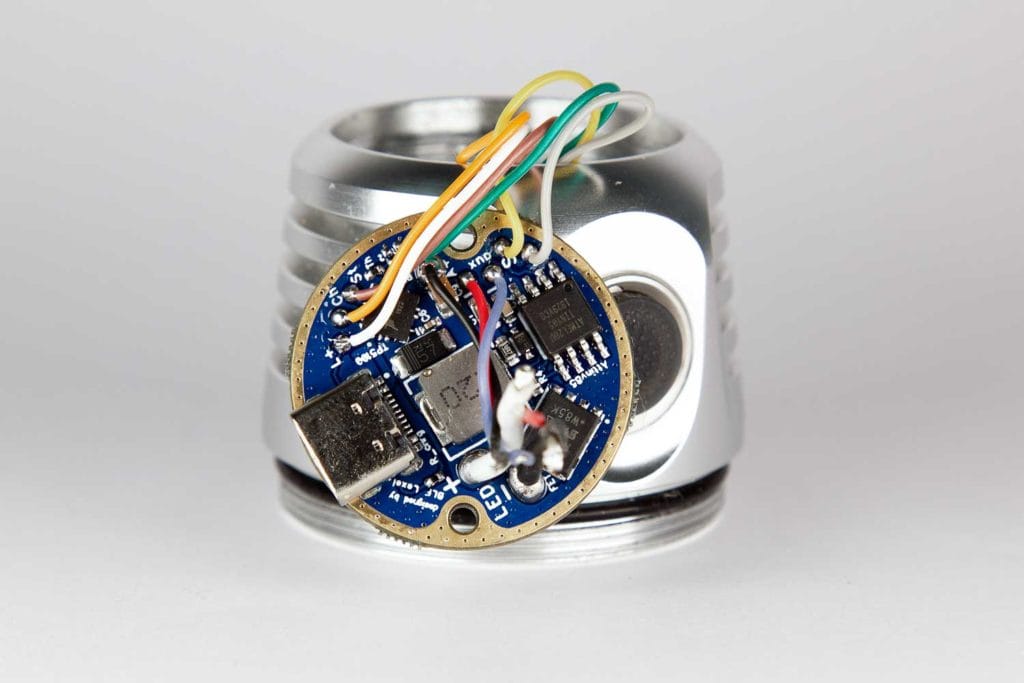
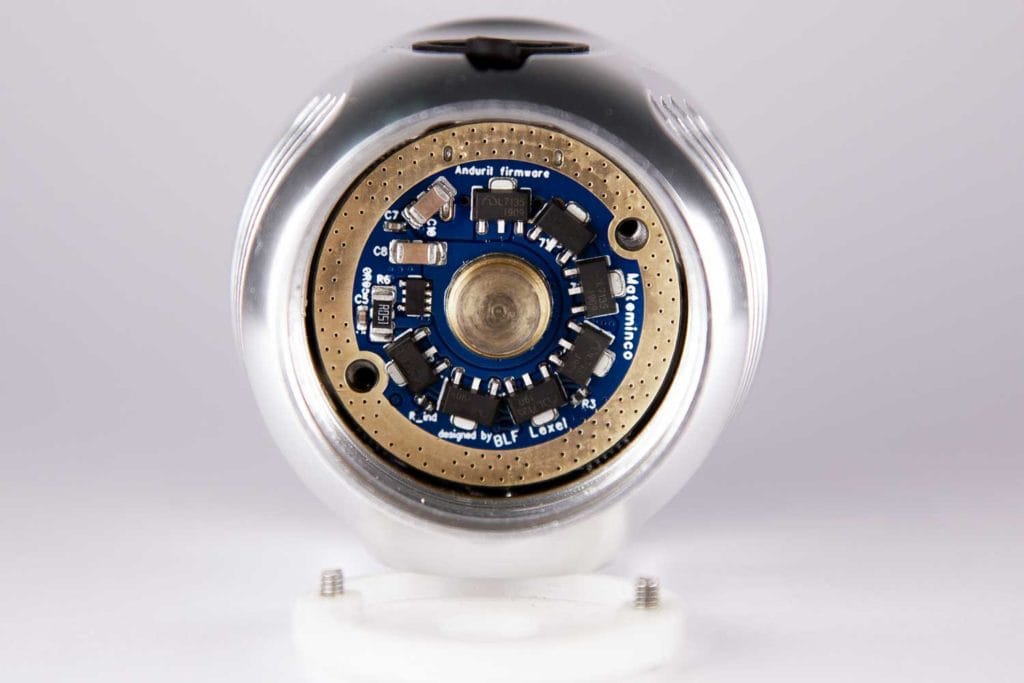
Batteries and charging:
First and foremost, this is a 26650 light. You can use 21700s and 18650s with the included adapters, but I have a minor beef with these – as they’re not the length of the inner tube, they’ll rattle back and forth as the light is moved. You can rip paper and fold it over to make a thick “ring” that will effectively extend the plastic tube, but I wouldn’t recommend it. While unlikely, the last thing you want inside a light is another potential fire risk.
I’m going to go out on a limb here and say that protected batteries will work, but only up to max-ramp. Hitting turbo will most likely trip the protection, so as with all FET lights, stick with high-drain unprotected.
As mentioned previously, charging a battery within the light is done via USB-C, but via a USB-C to USB-A cable – charging direct USB-C requires additional electronics, which I am led to believe increases the complexity of the circuits. It will charge at around 2A, with an LED on the switch indicating red while charging, and green when charged.
Performance:
All of my readings were taken from a fully-charged Keeppower 15A 5200mAh 26650 and a Samsung 40T 21700 – I recharged them between each test. I tested current with a Fluke 87 and short 12AWG wires, to eliminate losses over wire.
Amp measurement (at tailcap)
I measured both ramped and stepped mode. The default firmware doesn’t have a “flash” in the middle (top of regulated mode), so I haven’t measured that – I plan to modify the latest version of Anduril to add that back in and reflash the firmware soon, and will take a measurement as close to max regulated as I can.
Standby current:
- ~245 μA – though this is dependant on trimmer adjustment/LED brightness on the AUX board. I’ve adjusted mine to what works for me.
Ramping:
Harder than expected. Due to the nature of ramping, picking spots in it is almost impossible, so I’ve just done bottom and top of ramp, plus turbo.
| Mode | Keeppower 15A 26650 | Samsung 40T |
|---|---|---|
| Bottom of ramp (moonlight) | 2 mA | 2 mA |
| Top of ramp | 5.6 A | 5.9 A |
| Turbo | 15.06 A | 17 A |
Stepped:
The stepped mode is identical until the highest mode – which lines up fairly neatly with the idea being that Step 6 is fully regulated mode (7*7135).
| Mode | Keeppower 15A 26650 | Samsung 40T |
|---|---|---|
| Step 1 | 10 mA | 10 mA |
| Step 2 | 54 mA | 54 mA |
| Step 3 | 179 mA | 179 mA |
| Step 4 | 487 mA | 487 mA |
| Step 5 | 1085 mA | 1085 mA |
| Step 6 | 2.4 A | 2.4 A |
| Step 7 | 5.4 A | 5.9 A |
Runtime graph
Aaaand off a cliff we go. This isn’t unexpected; high output lights like this generate a lot of heat, and without a large thermal mass to dissipate it, the drop in output is going to be rapid and hard. What I didn’t expect though was that it drops down to ~5-6% relative output, and stay there for so long. As you can see, I got a slight increase as time went on, but I believe this is due to the room temperature dropping over time.
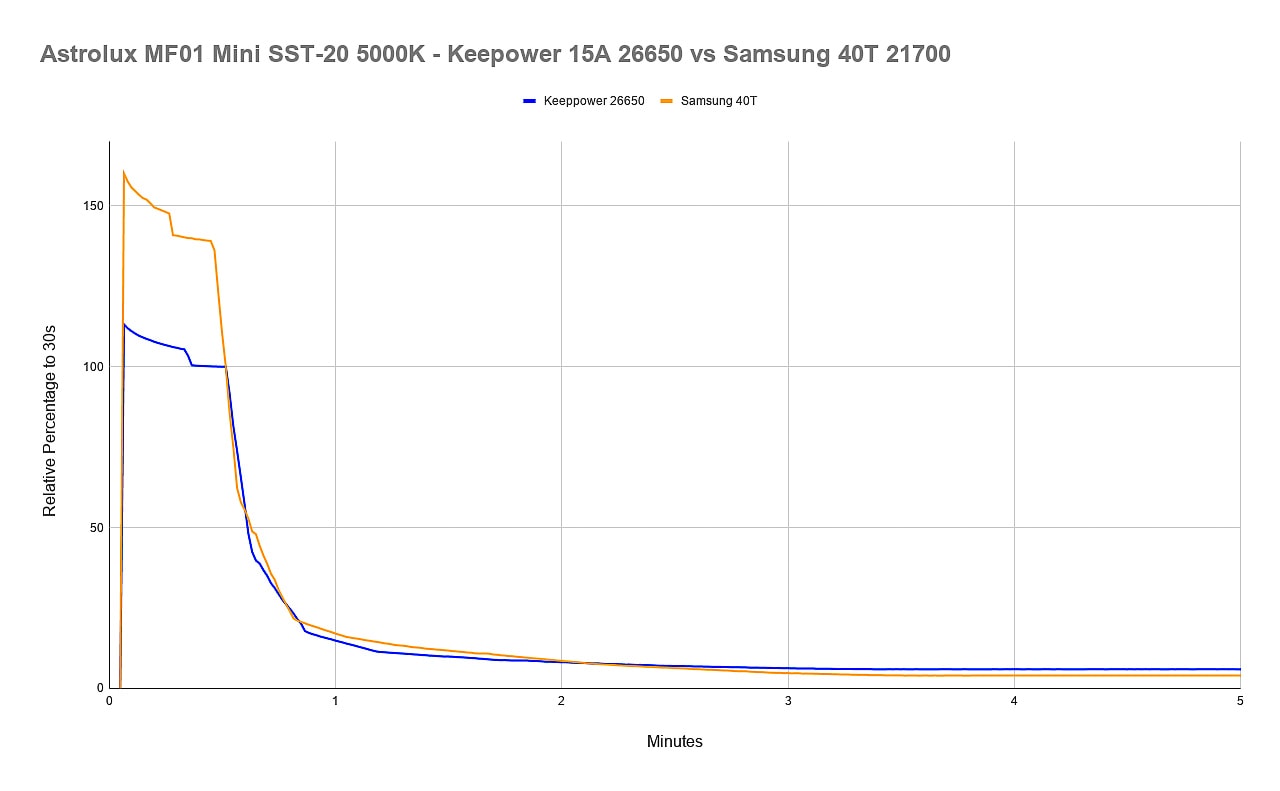
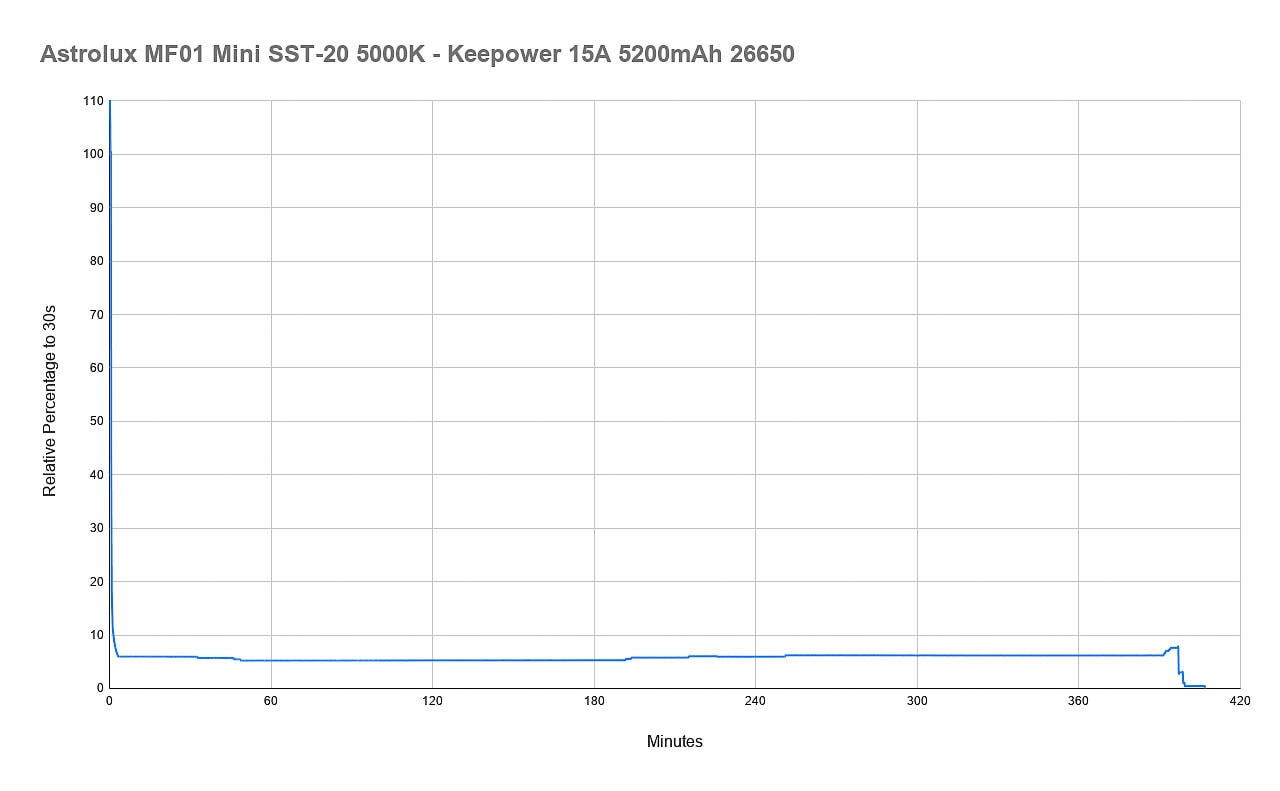
Almost 7 hours later, I turned the light off at <1% relative brightness, and the battery measured at just over 3V.
Astrolux MF01 mini Lumen measurements (for each mode)
Tested with 2 batteries:
Keeppower 15A
- Top of ramp: 2200lm
- Turbo: 5426lm
Samsung 40T 21700
- Top of ramp: 2524lm
- Turbo: 6069lm
Note though that those readings don’t last very long at all due to the huge amounts of heat being put out.
Astrolux MF01 Mini Throw numbers:
Measurements were taken both indoors and outdoors with the Uni-T UT383S. I took three measurements at both 5m for indoors and 10m for outdoors, and so as to account for any variance in my aim, I’ve averaged the results. Given that this light is a multi-emitter light, I’ve set the lux meter to “max” mode and waved the light gently around to let all of the hotspot hit the sensor, so as to capture the brightest point.
Using turbo mode only, I get:
Indoors (5m)
- Keeppower 15A: 38000cd = 390m throw
- Samsung 40T: 43725cd = 418m throw
Outdoors (10m)
- Keeppower 15A: 47500cd = 436m throw
- Samsung 40T: 59700cd = 489m throw
I… I really don’t have a good explanation on this one. I thought my outdoor tests were wrong, so I recharged the batteries, went back outside to do them again… but they got (slightly) higher. I’ve therefore just averaged the outdoor results.
As expected though, the 40T thoroughly outclasses the Keeppower battery.
BONUS section: Modding options and thoughts
Realistically, there’s not a whole lot that I’d change on this light. In a perfect world I’d swap the emitters out with Nicha 219b sw45k, and will be doing so when a recent purchase arrives. The FA3 bin of SST-20 that Lumintop have put in the FW3A are also nice, but again, are hard to find by themselves.
I’m the type of person, however, that isn’t satisfied with resting on a light as-is, and so here are the options I’d consider.
As I mentioned above, a lot of SST-20s exhibit a rather “green” tinge on low modes, and the way to deal with that in situ is a Lee Minus Green 248 filter. It’s a filter primarily used in photography to give a more pink tint to things; when put on a light it can lower the duv to below the black base locus, and eliminate the green. It has the unfortunate effect of lowering brightness by a decent amount – but if you’re a tint snob, it’s a sacrifice worth making.
Removing the TIR and making the light a “mule” can also make the tint less green, as the green is more aimed sideways out of the emitters, but this eliminates most of the usefulness of having a high lumen count.
Given that it’s an Andúril light, the firmware can be updated as ToyKeeper releases new functionality. To do so, you need to remove the battery tube, then unscrew the plastic cap in front of the driver. Then you will need to remove the bezel, glass, and TIR.
Now the fun* part.
You need to desolder the AUX board’s tiny wires, and then the MCPCB wires, at which point, the driver should slide out a little. You will then need to be very careful so as not to put excess strain on the wires from the switch. Then attach your SOIC clip, fire up your command prompt/terminal, and flash away. Reverse to put it all back together, and lament the fact that I ever mentioned this was possible as you struggle to solder the wires back on, all the while cursing my name.
*not actually fun
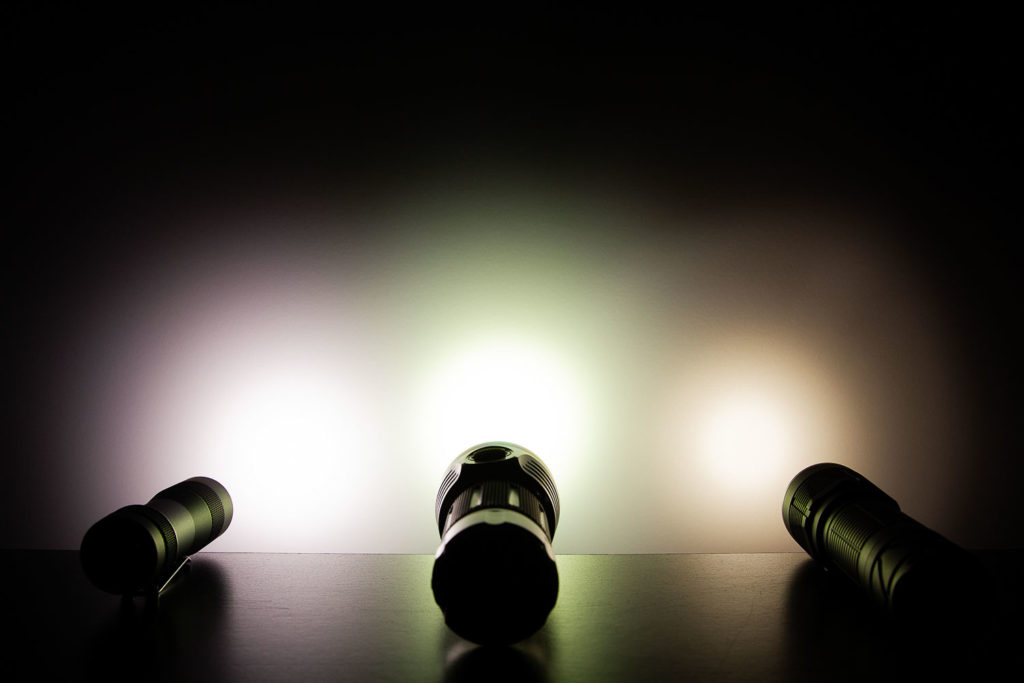
Disclaimer: The light was provided for review by Banggood. I have done my best to be as balanced as possible.
Overall conclusion
Pros:
- Lots of emitters!
- Lots of lumens!
- Anduril!
- Lots of battery options!
- Beautiful AUX leds!
Cons
- 5000K SST-20 are suuuuper green at low modes.
- Clear anodisation shows marks more than a colour.

Overall Rating: 4 stars: ★★★★☆
I’ll start the verdict off by saying – I love this light. Being the pint-size sibling of the MF01/MF01S, it was always going to be a show pony. Want to throw a huge chunk of lumens over there in a small package? You got it. Want long runtimes at a low brightness level? Settling in for the long haul. Want (arguably) the best flashlight UI going? Bam. The only thing that brings this light down for me is the SST-20 5000K. I’m a self-avowed tint-snob, so the green on lower modes kills me. The 4000K is, from everything I’m reading, fantastic – a chunk of lumens less, but the tradeoff of a lot less green, and high CRI.All that said though, it’s still a solid 4-star light – with emitters with a nicer tint, I’d happily give this 5 stars. Even still, it’s sitting very high on my list of favourite lights.
Astrolux MF01 Mini for sale
This flashlight is discontinued. If you’re looking for a great alternative, check out one of the following buyers guides we wrote after reviewing 100s of flashlights.
1lumen selects and reviews products personally. We may earn affiliate commissions through our links, which help support our testing.